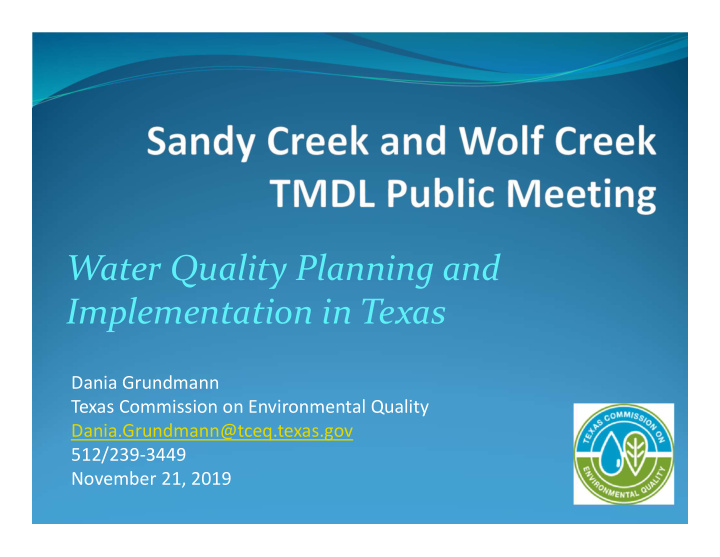



Water Quality Planning and Implementation in Texas Dania Grundmann Texas Commission on Environmental Quality Dania.Grundmann@tceq.texas.gov 512/239-3449 November 21, 2019
The Law requires us to determine… What are the problems? How bad are they? How can they be addressed? Enterococcus
Texas Surface Water Quality Standards Explicit goals for the quality of streams, rivers, lakes, and bays throughout the state Texas Surface Water Quality Standards are Texas Surface State Rules codified in Title 30 Chapter 307 Water Quality of the Texas Administrative Code Standards The Standards identify appropriate uses (and associated criteria) for surface waters: Aquatic life Recreation Public Water Supply Fish Consumption/Oyster Waters
Standards for Selected Streams
Primary Contact Recreation Use Primary contact recreation (PCR) activities are those involving a significant risk of ingestion of water, such as wading by children or swimming. The PCR use is not met if the geometric mean of all indicator bacteria is greater than: 126 cfu/100 mL for E. coli in freshwater streams 35 cfu/100 mL for Enterococci in tidal streams PCR is the presumed use for Texas streams. Recreational use analysis can be conducted to confirm actual historical use. PCR has been confirmed for Sandy and Wolf Creeks.
Monitoring The SWQM program coordinates the collection of physical, chemical, and biological samples from more than 1,800 surface water sites statewide. Surface water data collected by Clean Rivers Program partners, and other local, regional, and state cooperators. This data may be used by TCEQ to determine compliance with the Texas Surface Water Quality Standards through the Texas Integrated Report. Sandy Creek Lower Neches Valley Authority (LNVA) Wolf Creek LNVA
Assessment The Texas Integrated Report of Surface Water Quality Requirement of Clean Water Act Sections 305(b) and 303(d). Assessment period of seven years New report every two years in even-numbered years. The 303(d) List is submitted to EPA for approval. 2016 Texas 303(d) List EPA approved August 2019 Draft 2018 Texas 303(d) List TCEQ approved September 2019 Pending EPA approval
Section 303(d) of the Clean Water Act Identify water bodies that do not meet water quality standards, or are not expected to meet standards within two years (threatened) Establish schedules for developing total maximum daily loads (TMDLs) Develop TMDLs and Implementation Plans that identify parties responsible for reducing pollution loads
TMDL: Total Maximum Daily Load How much is too much? How bad is the problem? Where is it coming from?
TMDL – Total Maximum Daily Load Determines the maximum amount (load) of a pollutant that a water body can receive and still maintain uses Allocates this load to broad categories of sources in the watershed. Adopted by the TCEQ Approved by the EPA
Implementing Legislation Federal mandate for state TMDL programs: Clean Water Act of 1972 and its amendments Section 303(d)(1)(C) of the Clean Water Act; EPA’s implementing regulations in 40 CFR 130 Texas develops TMDLs for water bodies in Category 5 of its Texas Water Quality Inventory and 303(d) List
Wolf Creek (0603B) From the confluence of B.A. Steinhagen to the upstream perennial portion of the stream south of Colmesneil (two assessment units) Lower portion – elevated bacteria levels since 2006 Integrated Report 157 cfu/100mL E. coli (Dec. 2009 – Nov. 2016)
Sandy Creek (0603A) From the confluence with B.A. Steinhagen Lake upstream to headwaters at RR 255 (two assessment units) Lower portion - elevated bacteria levels since 2000 IR 173 cfu/100 mL E. coli (Dec. 2009 – Nov. 2016)
Potential Sources of Bacteria • Wastewater treatment facilities, • Urban stormwater runoff not covered by permit, • Land application fields, • On-site sewage facilities, • Wildlife, • Agricultural activities and animals, • Unmanaged and feral animals, and • Domesticated animals/pets
TMDL Equation TMDL = WLA (WWTF) + WLA (RSW) + LA + FG + MOS WLA (WWTF) – wasteload allocation for WWTF discharges WLA (RSW) – wasteload allocation for aggregate regulated stormwater discharges LA – load allocation FG – future growth MOS – margin of safety Units per day
TMDL Allocations
Questions? Dania Grundmann 512-239-3449 Dania.Grundmann@tceq.texas.gov
Recommend
More recommend